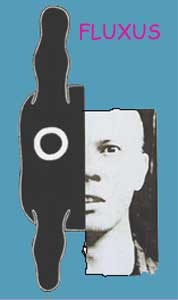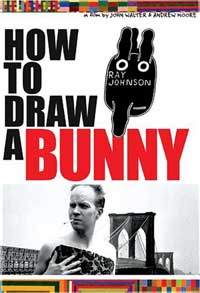If you don't already know what Fluxus, the New York Correspondence School, or International Mail Art is, I'm not sure How to Draw a Bunny (2002) ever really gets round to making it clear what it was that modern artist Ray Johnson did, or how it was he became world-known while avoiding, for most of his life, gallery exhibitions or commercial exploitation of his quirky talents.
 I suppose most people who seek out this documentary don't need any of it explained. But I do believe Ray is an interesting enough & appealling enough character that making the nature of his art understandable "outside the choir" would've been of service. I suppose most people who seek out this documentary don't need any of it explained. But I do believe Ray is an interesting enough & appealling enough character that making the nature of his art understandable "outside the choir" would've been of service.
The documentary is an intriguing expression of the director's personality as well as that of Ray Johnson. The jazz drumming that afflicts the soundtrack & many pictorial choices have more to do with the documentarian's tastes & personality than they have to do with Ray. This isn't entirely a criticism as art should be personal & a well done documentary certainly is art.
And if after viewing How to Draw a Bunny it still seems liike Ray is inaccessible, well, that's how he seemed even to the majority of his friends. A gay artist of the Warhol circle, Ray's eccentricity & even his physical beauty made him a perfect candidate for success within the New York pop & modern art movement. Yet being the least commercially oriented in terms of salesmanship & self-promotion, he remained somehow a mysterious satellite, never the dada lion he might have become if he'd been willing to "play the game" a little more.
I've been part of the mail art community since the 1970s & I have a few of Ray's works tucked away somewhere. His sincerity & generosity as a mail artist, his commitment to "free" art even if only altered xeroxes, his embracing of a far-flung community of minor & outsider artists whose affection for him could never be turned into profit...I don't believe How to Draw a Bunny conveyed any of that, & it was almost like the documentarians themselves didn't much understand what the international mail art community was & is about.
With the documentarian's desire to keep Ray connected to the likes of Warhol & Jasper John & Christos, I don't believe John Walter ever quite got round to showing that Ray remains world-known & his collages treasured world-wide because of his connection to fellow mail artists, a horde of individuals who lack Ray's modern art-history significance but who are the ones really responsible for keeping his name a living vital cultural reference. The world knows Warhol, but the mail art community knows Ray Johnson.
Whatever its limitations, the documentary is joyful because it shows a lot of Ray physically, droll & laconic in photos & video tape & readings of some of his letters. To see him standing, talking, walking, performing his strange purposeless nothings, to hear his words, is a tremendous joy. The mystery of his final bit of performance art, which was his suicide, is conveyed with such perfection as to almost seem romanticized, & I'm somehow glad of it.
And I appreciated the walk through his living & working space. I'd only ever had it described to me, boxes of accumulation stacked in every room more warehouse than home, & I'd somehow always pictured it as chaotic. But he was extremely ordered & tidy, & to imagine Ray at work, asleep, or eating meals, in this maze of perfect organization, was something I had somehow never accurately envisioned. So John Walter managed to change, just a little bit, & for the better, how Ray lives in my imagination.
If you'd like to know more about the mail art community,
go to:
Paghat's Mail Art Pages
copyright © by Paghat the Ratgirl
|

 I suppose most people who seek out this documentary don't need any of it explained. But I do believe Ray is an interesting enough & appealling enough character that making the nature of his art understandable "outside the choir" would've been of service.
I suppose most people who seek out this documentary don't need any of it explained. But I do believe Ray is an interesting enough & appealling enough character that making the nature of his art understandable "outside the choir" would've been of service.